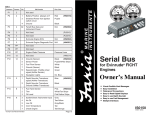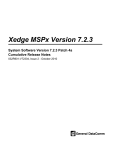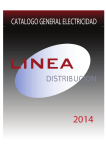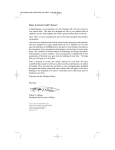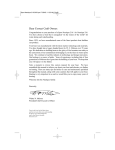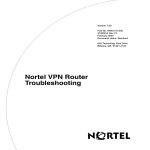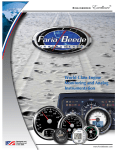Download Faria Instruments GW0016 User's Manual
Transcript
M Serial Bus for Navy Gateway GW0016 Owners’s Manual • Visual/Audible Alert messages • Easy Installation • Waterproof Connections • Easy to read Digital displays • Multiple Interfaces IS0210 rev. A ecr#4821 Aug. 2004 Table of Contents Quick Reference turn system on/off turn on instrument lighting change lighting intensity disable audible alarm in Normal Mode change LCD display reset Trip Fuel Consumed Specifications Turning the Gateway system ON/OFF System description Installation System Operation Tachometer/Fuel Management canceling system alarms engine hour meter total fuel consumed instantaneous fuel consumption trip fuel consumed clear trip fuel consumed fuel remaining fuel remaining alarm setting voltmeter Figure 1 (Tachometer Display Sequence) LCD Alarm Condition displays canceling system alarms Faria® Bus Installation and Wiring Guide installation Gateway™ box instruments Appendix 1 Installation and Wiring Figure 2 (Typical Power Connections) Figure 3 (Typical Instrument Connections) Figure 4 (Miscellaneous Connections) Figure 5 (Fuel Flow Connections) page 2 page 2 page 2 page 2 page 2 page 2 page 2 page 3 page 3 page 3 page 3 page 3 page 3 page 4 page 4 page 4 page 4 page 5 page 5 page 6 page 6 page 7 page 7 page 8 page 8 page 9 page 9 page 9 page 9 page 10 page 11 page 11 page 12 page 12 Navy Gateway (GW0016) System Manual intensity is reached no further changes can be made by pressing the “DOWN” button. The system consists of: • One Gateway box to interface with engine and external senders and sensors. • One 4” Tachometer with Fuel Monitor • Various 2” instruments, including but not limited to • Voltmeter • Oil Pressure gauge • Fuel gauge • Engine Temperature gauge • Transmission Temperature Quick operation: 1. To turn on the system: Turn the ignition key to “ON” position. 6. To disable the audible alarm in normal mode: PUSH and HOLD both the “UP” and the “DOWN” buttons on the tachometer until the beeping stops. 7. To change the LCD display (engine hour meter, system voltage): a. Pressing the “Mode” button on the tachometer will select the next LCD display. 2. To turn off the system: Turn the ignition key to “OFF” position. 3. To turn on instrument lighting: Turn on the light switch on the vehicle instrument panel. 4. To turn off instrument lighting: Turn off the light switch on the vehicle instrument panel. b. Press the “Mode” button repeatedly until desired function is displayed. The gateway will switch to a screen displaying the function data within 2 seconds after the button is pressed. 5. To change the lighting intensity, (requires the light switch be turned on): a. Turn on the light switch as described in item 3 above. b. Pushing the “UP” button on the tachometer will increase the intensity of the instrument lighting. When maximum intensity is reached no further changes can be effected by pushing the “UP” button. c. Pushing the “DOWN” button on the tachometer will decrease the intensity of the instrument lighting. When minimum 8. To reset Trip Fuel Consumed: a. Use quick operation 7 above to show “CLR TRP” on the LCD. Hold the “M” button for more than one second while the LCD displays “CLR TRP” to clear the trip amount. Page 2 Gateway System Specifications: Operation voltage: +12 V DC or +24 V DC +12 V DC (10 V DC (Min.) to 16 V DC (max.)) +24 V DC (20 V DC (Min.) to 32 V DC (max.)) Maximum Current with maximum backlight: < 1500 mA @ 12 V DC Minimum Current at switch off status: < 10 mA @ 12 V Operational temperature: -40˚ F to 185˚ F (-40˚ C to 85˚ C) Storage temperature: -40˚ F to 185˚ F (-40˚ C to 85˚ C) System Description ♦ There are three push buttons (Mode, UP, and DOWN) for selecting different message screens, changing the instrument lighting intensity, disabling audible alarm, etc. ♦ Audible and visual alarms. The LCD will display Warning messages while an audible “beep” occurs. ♦ The Gateway is environmentally sealed, and is water resistant per SAE J1960 paragraphs 4.6.2, 4.7.1.2 and 4.8.1.2. ♦ Faria® serial bus gauges/light arrays can be connected up to 120 feet (40 meters) from the gateway box. Turning the Gateway System ON/OFF When the “ignition” switch is turned to the “on” position, the system is turned on. When “ignition” switch is turned to the “off” position, the system will turn off. Page 3 When the system is turned on, the pointer on each of the instruments will be driven to its most counter clockwise position, all positions in warning arrays will light, and all LCD segments on the 5” tachometer are activated for 2 seconds. These actions provide a quick check of system operation. After this “boot-up” display, all instruments, warning light arrays and LCD screen will change to normal operating mode. Installation See Appendix 1: “Installation and Wiring” at the end of this manual. System Operation: After installation in accordance with the instructions and recommendations in the Installation section (see Appendix 1), the system is functional. Tachometer / Fuel Management The Serial Bus Tachometer / Fuel Monitor instrument provides both the functions of a tachometer and a fuel and engine monitoring system. The analog tachometer is a stepper motor instrument which looks like a standard analog device but which is actually a digital instrument. On small pointer movements you may occasionally see the pointer moving in the one-third degree “steps” that represent the accuracy of the instrument. The LCD shows messages, like engine hours, system voltage, and engine alarm conditions. In order to minimize “false” alarms, the “low voltage” alarm only functions when the engine is known to be running based on the presence of tachometer data. Several alarm conditions may also be displayed in the LCD display when needed: 1 2 3 Low fuel Low oil pressure Low voltage Alarm messages will be displayed on the tachometer LCD display. Messages will also include a flashing red light. All messages will be displayed until either the problem is corrected or the operator manually cancels the warning message. Canceling system alarms To manually cancel system warning messages, simultaneously press both the “Up” and “Down” buttons on the tachometer. This will disable the warning message temporarily. If the problem is not corrected in 1 minute (5 minutes for low fuel), the warning will be displayed again. The operator can cancel as often as desired. The LCD screen displays the data for the remainder of the functions. If there are no alarm conditions, “Instantaneous Fuel Consumption” is displayed on start-up. A short press of the “Mode” button advances the display through the five normally available functions. There are four functions displayed by the Fuel Management system in normal mode. Instantaneous Fuel Consumption Displays the actual amount of fuel being consumed per hour under the current operating conditions. Default display will show “G/H XX.X.” Pressing the “Mode” button for more than one second will allow selecting the units of measure. Default display will show “G/H XX.X.” Engine Hour meter Displays the number of hours that the engine has been operated. The display will show “XXXX.XHr”. A short press of the “Mode” button advances the display through the options. There are no adjustments for this function. Total Fuel Consumed “Total Fuel Consumed” is provided to allow monitoring of fuel usage over a longer period of time, like a month or the season. In order to prevent accidental reset, this function must be accessed only using a special “power on mode.” Options are: a) US gallons Page 4 b) Imperial gallons. Display will show c) Liters. Display will show Leaving the display in one of the items above while the “Mode” button is pressed and held for more than one second will save the selected units. Trip Fuel Consumed Displays fuel consumed since last reset. This function can be reset to zero before a trip to show fuel consumed during the trip. Display shows “TRPXXX.X.” Pressing the “Mode” button for more than one second while the display shows “CLR TRP” will clear the trip amount and set the menu back to the Trip Fuel Consumed function. A quick press of the “Mode” button will skip this feature. b) Adjust Trip Fuel Consumed, (fuel flow calibration). Display will show “ADJ TRP.” Pressing the “Mode” button for more than one second will cause the display to go into the Trip Fuel Consumed adjustment menu. The display will show “ADJXXX.X.” Pressing the “Mode” for more than one second will access the options that are available for this function. A short press of the “Mode” button advances the display through the options. Display will show “TRPXXX.X.” Options are: a) Clear Trip Fuel Consumed. Display will show “CLR TRP.” Page 5 Pressing and holding the “Up” button will increase the amount and pressing and holding the “Down” button will decrease the amount. Consumed” display) this display will show the decreasing amount of fuel remaining. Holding the “Mode” button for more than one second while the display is showing “ADJXXX.X” will set the amount in the display “XXX.X” into the Trip Fuel Consumed and return to the Trip Fuel Consumed function. The difference between the original and the new amount of fuel will be used to change the calibration of the instant and accumulated fuel data. This feature allows the fuel flow system to be calibrated by accurately filling the fuel tank at the beginning and end of a trip. When the tank is refilled at the end of the trip, record the exact amount of fuel placed in the tank. Using the above method, adjust the amount of fuel shown in the “ADJ TRP” to match the amount of fuel recorded. Save the corrected amount as described above. The “Trip Fuel Consumed” in the previous menu can then be cleared for reuse or left to continue to accumulate fuel usage. Fuel Remaining Displays the fuel remaining based on a manually entered amount of fuel minus the amount of “Trip Fuel Consumed.” Display shows “REMXXX.X.” This reading is independent of the fuel “gauge” reading. In normal use, the amount of fuel in the fuel tank is adjusted manually when the fuel tank is filled so that this display shows the total amount of fuel in the tank. The “Trip Fuel Consumed” is then reset to zero. As fuel is used (displayed in the “Trip Fuel Pressing the “Mode” for more than one second will access the option available for this function. a) Add to or remove gallons from the Fuel Remaining. Display shows “R+-XXX.X.” Holding the “Up” button will increase the amount and holding the “Down” button will decrease the amount. Holding the “Mode” button for more than one second will set the remaining fuel to the value shown in the display and return the menu to the Fuel Remaining alarm Setting function. This feature allows the operator to accurately set the amount of fuel in the fuel tank when adding fuel. The accuracy of this manually entered value directly affects the Fuel Remaining and Fuel Remaining Alarm functions, and should be done carefully. Fuel Remaining Alarm Setting Displays the setting for the “Low Fuel” alarm. The display shows “ALRXXX.X.” Page 6 Tachometer Display Sequence When the “Fuel Remaining” reaches this amount, the “Low Fuel” alarm will sound and a warning LED will flash in the display. Quick Press The display will automatically go into “set” mode to allow the operator to reset the alarm value to a lower value to turn off the alarm if desired. If the option is set to zero, the “Low Fuel” alarm will be disabled. Quick Press M M Pressing the “Mode” button for more than one second while in the REM display will access the option available for this function. a) Set the amount of fuel remaining when the alarm will go off. The display shows “A+-XXX.X.” Hourmeter Inst. Fuel Consumption M US GAL M IMP GAL M Liters Quick Press M Trip Fuel Consumed M CLR TRP M ADJ TRP Quick Press Holding the “Up” button will increase the amount M Fuel Remaining M ALARM Quick Press M and holding the “Down” button will decrease the amount. Voltmeter Displays the System Voltage. There are no adjustments available. Page 7 Figure 1 Voltmeter LCD Alarm Condition Displays. Alarm messages will be displayed on the Tachometer LCD display. All messages will be displayed until the problem is corrected, or the operator cancels the warning message. Severe conditions includes a flashing red light. Low Battery Voltage (Flashing Red Light) Low Oil Pressure (Flashing Red Light) Low Fuel Level (Flashing Red Light) Canceling System Alarms To cancel system warnings messages, simultaneously press both the “Up” and “Down” buttons on the tachometer. This will disable the warning message temporarily. If the problem is not corrected in 1 minute (5 minutes for low fuel), the warning will be displayed again. The operator can cancel as often as desired. Page 8 Faria® Serial Bus Installation and Wiring Guide The system consists of: • One Gateway box to interface with the engine and external senders and sensors. • One 4” Tachometer with Fuel Monitor • Various 2” instruments, including but not limited to • Voltmeter • Oil Pressure gauge • Engine Temperature gauge • Fuel Level gauge • Transmission Temperature Installation Installation of the Fari® Serial Bus system is accomplished as follows: Gateway Box The Gateway™ box is the central unit of the system. As all of the senders and other information source peripherals connect to the Gateway™, the Gateway™ box should be mounted in a protected area in the best location to provide the maximum cabling benefit. The Gateway™ box power cable must be installed to allow connection to “battery positive” (always on), “battery negative” (ground), and a source of “switched power” which turns on with the engine ignition switch (see Figure 2 and Table 1). The “Faria® Bus” cable must be routed from the Gateway™ box to the instrument panel area to connect the instruments to the data bus and instrument power (see Figure 3). The remainder of the connections to the Gateway™ box are described below. Instruments The instruments are mounted using the provided back-clamps and mounting hardware. Each instrument comes with a bus connection cable (12”). The main “Faria® Bus” cable from the Gateway™ box is connected to the most convenient instrument using either of the two four (4) pin connectors provided on the instrument case. Each additional instrument is connected to the previous instrument using one of the 12” bus connection cables. The cable may be connected to either of the two connectors provided on the instrument case (see Figure 3). Page 9 Appendix 1. Installation and Wiring Table1 Connector Contacts P1 2 P2 4 Pin Pin Function Wire Color Not used 1 Battery Positive (always on)* 2 Ground 3 Switched Power from Ignition Red Purple switch circuit P3 4 4 Ground Black All Faria® Bus Data and N/A Instrument Power P4 2 Not Used (PJ0015) P5 3 Not Used (PJ0016) P6 3 Not Used P7 3 Not Used P8 PP Not Used P9 PP Not Used P10 PP Not Used P11 12 P12 12 P13 2 P14 6 P15 3 Navigation Lights Input Dk. Blue 4 Tachometer Input Grey 5 Fuel Flow Sensor Power Black 6 Fuel Flow Input White 7 Fuel Flow Ground Shield w/ heat shrink Not Used 1 Oil Pressure Sender Lt. Blue 2 Fuel Tank Sender Pink 5 Engine Temperature 6 Transmission Temperature 8 Not Used *5 amp Fuse Recommended Page 10 Faria Serial Bus Gateway Typical Power Connections Figure 2 P13 P7 P12 P15 P5 P4 P1 P11 P14 P10 P8 P6 P3 2 1 3 P2 4 Black Red Purple - SOP GEN + Battery Typical Instrument Connections Figure 3 PJ0018 Note: To help reduce moisture in the gauges be sure to install plug PJ0018 in all open connectors. P13 P14 Page 11 P7 P12 P15 P5 P4 P1 P3 P2 P11 P10 P8 P6 Faria Serial Bus Gateway Figure 4 Miscellaneous Connections Tachometer Input 6 7 5 8 P 4 9 1210 3P12 2 11 1 12 P13 P15 3 P 4 2 5 1 14 6 6 7 5 8 P 4 9 3 11 10 2 11 1 12 P7 P10 P8 P5 P6 P4 P1 P3 P2 Dk. Blue Pink Lt. Blue Fuel Tank Sender White Oil Pressure Sender Nav. Light Switch White Trans. Sender Instrument Backlight Control Engine Temp. Sender Figure 5 Fuel Flow Connections P13 P15 P14 P9 P12 5 6 7 P7 P5 P4 P1 P3 P2 P11 P10 P8 Fuel Flow Transducer Black White Shield w/Heat Shrink P6 Page 12 Copyright 2004 by the Thomas G. Faria Corporation, Uncasville CT No part of this publication may be reproduced in any form, in an electronic retrieval system or otherwise, without the prior written permission of the company. Faria® is the trademark of the Thomas G. Faria Corporation














